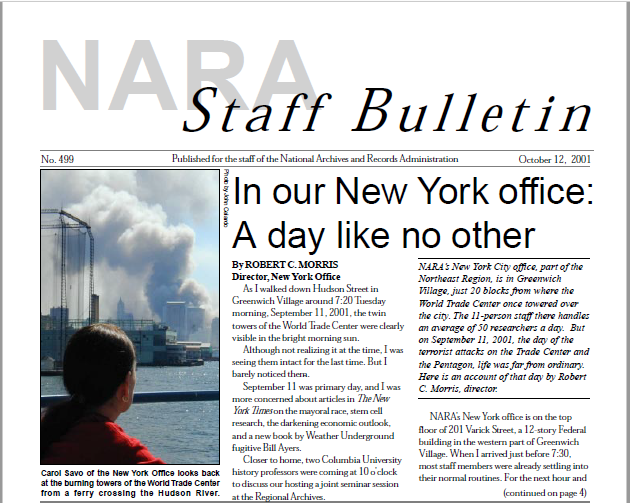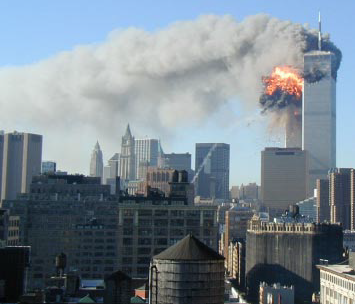9/11 Archives: “In our New York office: A day like no other”
By Victoria Macchi and Jessie Kratz | National Archives News
WASHINGTON, September 9, 2021 — Writing in a National Archives employee newsletter the month after the September 11, 2001, terrorist attacks, then-Archivist of the United States John W. Carlin noted what indeed would come to pass in the following years:
Someday far in the future, records held by NARA will tell the horrible stories of September 11, 2001, to the generations of Americans who will come after us. These Americans will reflect on how their country was forever changed in one single, devastating day. It is my hope that the records of this time of national tragedy will also reflect the truly amazing resilience, strength, and honor of the Americans who came together as a country to face new challenges.
The National Archives would go on to safeguard many documents related to September 11, including records of the 9/11 Commission and the 9/11 Federal Aviation Administration Records. In New York and at the Pentagon, the National Archives offered help to assess records damage, stabilize damaged records, and reconstruct files if possible.
Here, however, we are reprinting a piece that is close to home for the agency: for the first time on National Archives News, we are publishing the firsthand account from staff at the National Archives at New York City in the weeks following the 9/11 attacks.
Originally written as a dispatch for the employee newsletter by then-director of the National Archives at New York City Robert C. Morris, the words from the director and photos taken by archivist John Celardo live on as a testament to that day. The text is reproduced below in full. Celardo, who has since retired from the agency, has made 23 images he shot that day available to the public.
Editor's Note: This dispatch refers to the location of the National Archives at New York City at 201 Varick Street, which was home to the facility from 1992 to 2012. The area of the Varick Street building was the last line of tall buildings; looking downtown, the much lower buildings of Greenwich Village allowed for a clear view of the World Trade Center. The National Archives at New York City is now located in the Alexander Hamilton U.S. Custom House at 1 Bowling Green in Lower Manhattan.
Robert C. Morris died in 2003.
Dorothy Dougherty, Programs Director for the National Archives at New York City, contributed to this report.
This story was updated on September 10, 2021, with a link to John Celardo's photos.
“In our New York office: A day like no other”
ROBERT C. MORRIS
Director, New York Office
NARA Staff Bulletin, October 12, 2001; No. 499
[Original editor’s note] NARA’s New York City office, part of the Northeast Region, is in Greenwich Village, just 20 blocks from where the World Trade Center once towered over the city. The 11-person staff there handles an average of 50 researchers a day. But on September 11, 2001, the day of the terrorist attacks on the Trade Center and the Pentagon, life was far from ordinary. Here is an account of that day by Robert C. Morris, director.
As I walked down Hudson Street in Greenwich Village around 7:20 Tuesday morning, September 11, 2001, the twin towers of the World Trade Center were clearly visible in the bright morning sun.
Although not realizing it at the time, I was seeing them intact for the last time. But I barely noticed them.
September 11 was primary day, and I was more concerned about articles in The New York Times on the mayoral race, stem cell research, the darkening economic outlook, and a new book by Weather Underground fugitive Bill Ayers.
Closer to home, two Columbia University history professors were coming at 10 o’clock to discuss our hosting a joint seminar session at the Regional Archives.
NARA’s New York office is on the top floor of 201 Varick Street, a 12-story Federal building in the western part of Greenwich Village. When I arrived just before 7:30, most staff members were already settling into their normal routines. For the next hour and a half they checked their email, re-shelved naturalization records, answered reference letters, and assisted researchers in the reading room.
At 8:34 I responded to an inquiry about the best date for a program review. Around 8:45, senior records analyst Karen Lucas began her records management workshop with a short instructional film. A few minutes later, archivist John Celardo was putting the finishing touches on a genealogical inquiry: "Copies of the naturalization records you requested, along with a bill for..."
Then all hell broke loose.
In the stacks, archives technician Joe Majid heard an airplane overhead followed moments later by a loud rumbling. Karen Lucas saw a blinding white light through the drapes in the conference room. And when someone telephoned to say that an airplane had crashed into the World Trade Center, 20 blocks south of us, employees from all over the building began streaming to the café on our floor, where they could get an unrestricted view of lower Manhattan.
We were stunned by what we saw: Smoke billowing from 1 World Trade Center and a gaping hole toward the top of the building. Archivist Greg Plunges informed Karen Lucas what had happened, and she told the workshop participants. One person started screaming that it was a terrorist attack. Another turned on her portable television. People began asking if they were going to be dismissed.
John Celardo instinctively ran back to his office, grabbed our new digital camera, and headed for the roof. He snapped a few pictures, moving from one side of the building to the other to get the best shot. At 9:06, eighteen minutes after the first crash, three staff members saw a second jetliner fly directly into the other tower. With seven pictures still left in the camera, John captured the horrifying moment when a massive ball of orange flames erupted from 2 World Trade Center.
Early news accounts on the radio did not give a definite cause of the initial explosion, but the second crash left little doubt that this was terrorism. Details were still sketchy, however, and after reaching colleagues in Philadelphia and Waltham, I emailed College Park: “It seems that at least one plane has hit the World Trade Center, and both towers are on fire. We are told that all entrances in and out of the city are closed. I can’t get through to anyone on the telephone. We will keep you advised.” The time was 9:32.
Twenty-seven minutes later the unthinkable happened—the south tower collapsed, sending out shock waves that registered over 2.4 on the seismographs at Columbia University’s Lamont-Doherty Earth Observatory. John Celardo saw it happen in seeming slow motion. “The calamity of the event finally hit home,” he later recalled. “I fell to my knees and began to sob.”
Shortly after the collapse we heard the first announcement from the building manager’s office: “The building is secure. We are not in an emergency situation. Please remain at your work stations.” I nevertheless decided to dismiss those attending Karen Lucas’s workshop and four genealogists who were doing research.
As for the staff, we remained on the floor through one or two more announcements until someone came to the front door and yelled, “WE ARE EVACUATING NOW! LEAVE THE BUILDING NOW!” At 10:23 I emailed College Park and Waltham: “We are evacuating.” I made sure the staff was out, told a lone microfilmer in the stacks to leave, locked the door, and headed down to the street, not quite sure how any of us were going to get home.
By the time I reached the street, 1 World Trade Center, had also collapsed. Not even thinking to look back in that direction, I headed straight up Hudson Street to the train station, where other staff members were trying to catch a train to New Jersey. Although the station had closed 15 minutes earlier, crowds continued to mill around in the hope that it would soon re-open.
We waited for more than an hour before eating some sandwiches purchased at a nearby grocery store and heading over to the Hudson River. From there the eight of us walked nearly 30 blocks along the West Side Highway to an improvised ferry service from the Chelsea Piers to Weehawken, New Jersey.
At Weehawken, we and hundreds of other commuters boarded buses bound for Giants Stadium, where other buses were somehow supposed to distribute us. It did not work out exactly as planned, but, beginning with our arrival in the stadium parking lot around 2:30, each of us slowly made our way home. I drove into my garage before 5:00, and the last three staff members reached Bayonne around 7:00.
For the next couple of days, while 201 Varick Street was in the frozen zone below 14th Street, I watched the news and used my telephone and computer to keep in touch.
On Friday morning, after the mayor moved the line down to Canal, John Celardo and I came in and attended a meeting in which the General Services Administration outlined the impact of the disaster on Federal offices in New York. Some were destroyed, many displaced, and all buildings below Canal needed to be inspected.
One test found asbestos on the exterior of a building near the World Trade Center site. Fortunately, 201 Varick showed no signs of damage.
Once the frozen zone was moved, we re-opened to the staff on September 17 and to the public the next day, albeit in a totally different environment.
Our once-anonymous building is now surrounded by police lines and concrete barriers, and even Federal employees have to go through security checks. Houston and King streets are closed to through traffic. No unauthorized vehicles can park around our building. We have had to curtail our extended hours, and the number of researchers is roughly half of what it was before September 11.
Yet in the wake of the worst terrorist attack in American history, this NARA facility one mile north of ground zero is back at work if not back to normal. That will take much longer.


